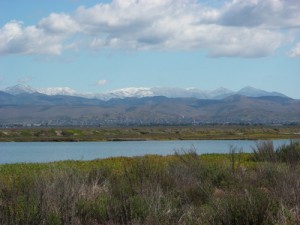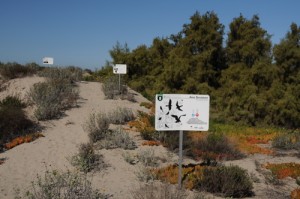South of Ensenada, on the road to the world-famous blowhole known as La Bufadora, there are some lesser-known delights often overlooked by tourists and even locals.
A large portion of the pueblo of Punta Banda consists of a five-mile sandbar extending between Todos Santos Bay and El Estero de Punta Banda. This estuary, and the surrounding marshes and dunes, comprise a Mexican Natural Protected Area that is home to nearly seventy species of marine and terrestrial birds. This includes several endangered species such as the light-footed clapper rail, the California least tern, California brown pelican and Belding’s savannah sparrow.
Only about two-thirds of this spit is inhabited; beyond that lies dunes, ocean and sky. Far across the bay, downtown Ensenada can be glimpsed, but from this vantage even the giant Mexican flag and the occasional ship heading into port seem insignificant. 
The mountains that encircle Ensenada and Todos Santos Bay form a distant ring that stretches from north to east to south; the only sounds are of birds, wind and surf. Even the light seems more golden on the far end of the spit.
You can enjoy this area by boat, on hiking trails, or by walking or biking down the smooth, sandy beach at low tide (cars and trucks are prohibited). Also, be aware that some of these birds build their nests on the ground; so walking in the dunes should be avoided during nesting seasons.
To get to the dunes, take the main road to La Bufadora through the small town of Colonel Esteban Cantu (or simply, Cantu).
 If you prefer to drive down to where the dunes begin, you’ll make a right turn onto the Not Z Road (at km. 12.5). The name of the road is not posted, but there is a small sign that says Agua Caliente. Follow this road all the way to the end. You’ll pass two guard shacks on the way. The first one is abandoned; when you come to the second one, just tell them you’re going to la playa (the beach).
If you prefer to drive down to where the dunes begin, you’ll make a right turn onto the Not Z Road (at km. 12.5). The name of the road is not posted, but there is a small sign that says Agua Caliente. Follow this road all the way to the end. You’ll pass two guard shacks on the way. The first one is abandoned; when you come to the second one, just tell them you’re going to la playa (the beach).
To explore the estuary by water, turn right past the second guard shack, beyond La Marina Restaurant. There you’ll find a free boat launch. 
Kayaking is a great way to explore the estuary and it’s not a difficult paddle if you flow with the tides. One caution: in a minus tide the mouth of the estuary (about two miles northeast of the launch) runs hard and may be hazardous for inexperienced kayakers.
If you plan to hike the dunes, continue to the end of the Not Z Road. From here you can take a short trail, marked with interpretive signs, from the end of the road into the dunes on the estuary side.  Another option is to walk along the beach on the bay side. This enables you to go all the way down to where the Estero de Punta Banda flows in from the bay. If you make your way around the tip of the spit, often you’ll be rewarded by the sight of sea lions sunning themselves on the beach.
Another option is to walk along the beach on the bay side. This enables you to go all the way down to where the Estero de Punta Banda flows in from the bay. If you make your way around the tip of the spit, often you’ll be rewarded by the sight of sea lions sunning themselves on the beach.
Another unusual feature of this area is a natural hot spring, located on the opposite end of the beach near the main road. These hot springs have been renowned for their healing properties since the late 1800s. At high tide the spring disappears under the water (making for some dramatic hot and cold currents if you go swimming), but at low tide the hot spots lie exposed for anyone with a shovel and some initiative to enjoy.
You may wonder, as I did, how it is possible for hot, fresh water springs to co-exist with the cold, salty ocean water. The explanation is that this region, like most of California, rests on fault lines. In Agua Caliente, deep fissures in the earth provide a direct route for magma-heated water to rise to quickly the surface. As it reaches the top of the sand, the fresh water mingles with salt water, dissipating its heat, but if you dig your finger in even an inch, you may find the sand too hot to touch.
However, as you dig, the hot water should cool down just enough to provide you with a comfortable, heated pool. If not, you can always mix in some seawater. After all that manual labor you’ll be especially happy to lay back with a cold drink and enjoy your well-earned natural soak, complete with an ocean view.
The springs can be a little tricky to locate the first time you go, but once you know what to look for, it’s easy. To get there, grab a shovel and follow the main road (Carretera La Bufadora) to La Jolla Beach Camp. Turn right and go straight to the parking area. Once on the beach, look for the spots that appear wetter than the surrounding sand at low tide. There may even be steam rising. You’ll know for sure you’re in the right place when you touch the sand and find it warm. Then all you have to do is dig!


I just moved to Punta Banda from the states and having been involved in the aquarium hobby was surprised to find rental units and homes for sale with plumbed hot seawater pumped from a well at La Jolla camp….
I know, isn’t that a great use of a natural resource? I wish I had a seawater jacuzzi in my house!
Although I’m pushing 60 now, my brother and I used to cook hotdogs in the heated sand as kids. (Wrapped of course). I don’t get to go as often as I’d like these days but plan to drastically increase the trips to my place soon. Alex, Mike and Alex Jr. (As well as all the other brothers) are truly great people and some of my oldest friends. Reading this is making me homesick. See you soon!
Our family from Orange County, California, used to camp on the inland side of the sand dunes at Punta Banda from the mid-1960s to late 1970s. That was when there were no homes on most of the peninsula and it was still wild and natural. It was beautiful and great for three very young brothers (me included) and our baby sister, to play and have fun. I had not been there since the late 70s until this past weekend and was sad to see that much of the peninsula has been developed with private homes, with many sand dune areas bulldozed years ago to make way for them. However, reading this online article, I feel somewhat better that at least part of the peninsula and its sand dunes, etc., are now protected. I hope they will continue to be kept safe. Before Punta Banda, we often camped on the other side of the estuary at Estero Beach. That was also a lot of fun where we could take our rubber raft as kids. However, I will never forget the American college-age guys who drove their new pickup all the way to the end of the peninsula overlooking the estuary. They parked the vehicle on the beach at low tide and then went off to presumably explore the dunes. We kids watched from our perch at Estero Beach as the tide slowly came in. It was too far to yell a warning and the group was nowhere to be seen. Finally, the owner of the truck and his buddies frantically tried to start and drive/push the truck out from the incoming seawater, but the tires sank into the sand. Over the course of several minutes, we watched the nice truck become awash with the deepening salt water. I learned that day that you never leave your vehicle parked on an ocean beach and then walk away.
Hi, do you have any recommendations on where to stay to be close to the hot springs? We are thinking about going to baja next weekend.
There are lots of options listed on VRBO and through AirBNB. It’s a beautiful place to get away. Gets busy on weekends and holidays in summer, but otherwise it is a relaxing spot.